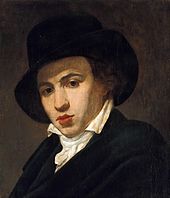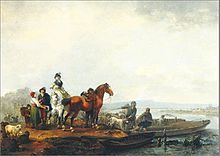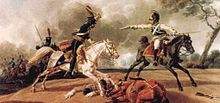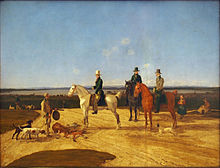Wilhelm von Kobell

Wilhelm Alexander Wolfgang Kobell or Kobel, from 1817 Ritter von Kobell (born April 6, 1766 in Mannheim , † July 15, 1853 in Munich ) was a German landscape , animal and battle painter .
biography
origin
Kobell grew up in the artistic and civil service milieu of the Palatinate residence city of Mannheim, a first-rate cultural center in what was then Germany. His parents were the landscape painter and etcher Ferdinand Kobell (1740–1799), who completed his training in Paris from 1768–1770 , and the daughter of the councilor Maria Anna Lederer (1744–1820) from Düsseldorf . The Kobell family came from Hesse . One of the father's brothers was the landscape draftsman Franz Kobell (1749–1822), who stayed in Rome from 1776–1784 . Dutch artists, such as the marine painter Hendrik Kobell (1751–1779), came from a great uncle of Wilhelm who had emigrated to Rotterdam .
Training in Mannheim

The father directed Wilhelm's artistic training. He also attended the Mannheim drawing academy around 1780–1784 . From 1786–1789 he worked in his father's workshop, but had already received orders himself. At that time the first watercolors with landscapes, portraits of family members and friends as well as reproductions of paintings by Dutch masters (including Philips Wouwerman ) in aquatint style were created . Kobell drew a lot in the great outdoors. In addition to the Dutch painting of the 17th century , according to Wichmann, those of the 18th century, but also contemporary art, especially England, may have influenced him. The development of his drawing handwriting indicated early on that he would be “one of the most important artists of the late 18th century”.
Relocation to Munich
Elector Karl Theodor von der Pfalz had also been Elector of Bavaria from 1777 . Many Palatinate officials were therefore transferred to culturally backward Munich. Those who didn't have to, prefer to stay in enlightened Mannheim. Kobell visited the Bavarian royal seat for the first time in 1789. In 1791 Karl Theodor promised him a scholarship of 400 guilders for planned trips to Italy and England, and the Berlin Academy appointed him a foreign member. Because the First Coalition War broke out in 1792 , he had to forego the trips mentioned. He went to Munich again and was appointed there by the elector as court painter with an annual salary of 500 guilders. In 1793 he moved with his younger brother Egid to the Bavarian capital, where the two lived together for the next four years. In the 1790s, line etchings were created in the Aberlian manner , some of which were colored so perfectly with watercolor that they could easily be mistaken for drawings.
In Munich in 1797 Kobell married Marianna von Krempelhuber (1775–1839), whose father Sebastian (1739–1818) was a state director. Their dowry enabled him to have a secure life. He also sold works to dealers and princes, for example in 1798 to Karl Theodor's future heir, Duke Max Joseph of Pfalz-Zweibrücken . By 1807 Marianna had two sons and three daughters. After the marriage, Kobell spent the summer months at Emming Castle (on the site of today's St. Ottilien Abbey ), which belonged to his father-in-law, hiked through the Upper Bavarian plateau and painted landscapes with cattle, country people, hunters and riders.
Because of the war, Kobell's father Ferdinand moved with the rest of the family to Munich in 1794. In 1798 he was appointed director of the Kurpfalzbayerische Gemäldegalerie by Karl Theodor , which had been evacuated from Düsseldorf in 1795. But he died in 1799.
Battle painter

The circumstances of the time offered the landscape and animal painter Kobell the military as an additional subject . In Mannheim and later also in Munich he saw Austrian and French troops alongside local troops. In the Second Coalition War , Moreau occupied the states of Max Joseph (1799-1825) in 1800, who, like his predecessor, had joined the opponents of France . Finally the French general defeated Austrians and Bavaria at Hohenlinden . As a result, the electorate - subjected to a revolution from above by Montgelas , enlarged with the blessing of Napoleon and elevated to a kingdom - a satellite state of France .
After Kobell had first painted scenes from the life of a soldier, Max Joseph ordered seven depictions of Napoleon's victories over the Austrians who invaded Bavaria in the Third Coalition War (1805) as a present for Marshal Berthier in 1806 . After the artist exhibited these paintings in 1807, Crown Prince Ludwig (I) commissioned him with the execution of larger-format works that were supposed to glorify the Bavarian acts of arms for and - after the defeat in Russia (1812) - against Napoleon. Ludwig was anything but a great general, he did not even take part personally in the most important battle involving the Bavarians (that at Wagram ). Kobell was occupied with the cycle of twelve paintings until 1816/17. His battle pictures are the result of extensive research and are characterized by remarkable realism . They have a source value for military history and uniform studies . Historical personalities are also depicted on it.
In 1808 the Vienna Academy appointed Kobell an honorary member. The professorship for landscape painting at the newly founded Munich Academy, however, was given to Johann Georg von Dillis (1759–1841). Kobell and his uncle Franz became members of a committee for the administration of Bavarian art treasures. Kobell spent the summer of 1809 in Vienna and the winter of 1809/10 in Paris with his brother Egid, who was there on a diplomatic mission.
From classicism to Biedermeier

In the pre- March period , especially under the repressive regime of Ludwig I (1825–1848), Kobell's style changed from a romanticizing classicism to a frozen Biedermeier . In the pictures of this creative period the plains of Bavaria show all their barreness, the mounted noblemen with their top hats (as well as their shadows) grow in length.
1814–1826 Kobell was Dillis's successor professor of landscape painting at the Munich Academy. He retired at the age of 60. In 1817 he received the Knight's Cross of the Order of Civil Merit and thus the personal nobility, which his younger brothers Egid and Franz had already achieved in 1809, and in 1833 - at his fourth request - the hereditary nobility.
In old age, the "lean, tall man with a pale, friendly face", according to Eisenhart, left the palette and grave mark and colored tiny drawings. He was 87 years old. His grave is on the Old South Cemetery in Munich (Gräberfeld 23, Row 13, Platz 20/21) ( location ).
Influential brothers
Kobell was well connected in Munich: his older brother Innozenz (1765-1818) belonged to the highest court in Bavaria. His younger brother Egid (1772–1847) was secretary of the government for 35 years, as well as superintendent of the Tegernsee country estate acquired by the king in 1817 . In 1834 he became a member of the Regency of Greece , in 1835 envoy to Athens , and in 1836 a real Council of State . He was succeeded by Wilhelm and Marianna's younger son Sebastian (1801–1875), who held it for 40 years, as Secretary General of the State Council. Finally, Wilhelm's youngest brother Franz (1779–1850) was Secretary General of the State Ministry of the Interior , father of the mineralogist and dialect poet Franz von Kobell (1803–1882) and grandfather of the writer Luise von Kobell, married von Eisenhart (1827–1901).
gallery
Landscape and animal pictures up to 1799
Approaching thunderstorm over Ammerland (1798).
Stagecoach in winter (around 1798), Frankfurt am Main .
Landscape and animal pictures 1800–1809
Rest plowing (1800), Schweinfurt .
Alpine lake and pasture with horses (after 1800), Darmstadt .
Horse market (1802), Frankfurt am Main .
Herd of cattle on the banks of the Isar near Oberföhring (1809).
Landscape and animal pictures 1810–1819
First Oktoberfest , 1810 (1811), Munich .
Isar landscape (1819), Munich .
Landscape and animal pictures 1820–1829
Landscape and animal pictures after 1830
Gentlemen riders
and country girls on the
banks of the Isar (1831), Berlin .
Battle pictures
The Siege of Cosel ( Koźle ), March 15, 1807 (1808), Munich .
Equestrian battle near Hanau, October 30, 1813 (1814), Munich .
Battle of Hanau , October 30, 1813 (around 1814), Albertina (Vienna) .
literature
- Johann Georg Meusel : Teutsches Künstlerlexikon (…) 2nd edition, 1st volume, Lemgo 1808, pp. 484–486.
- Georg Kaspar Nagler : New general artist lexicon (…) 7th volume, Munich 1839, pp. 99-102.
- Wilhelm von Kobell . In: Andreas Andresen : The German painter-etcher, maîtres-graveurs, of the nineteenth century according to their lives and works. 1st volume, Leipzig 1866, pp. 114-161, digitized
- Johann August Ritter von Eisenhart : Kobell, Wilhelm von . In: Allgemeine Deutsche Biographie (ADB). Volume 16, Duncker & Humblot, Leipzig 1882, pp. 357-359.
- Luise von Kobell: Among the four first kings of Bavaria. After letters and personal memories. 1st volume, Munich 1894 ( digitized version ).
- Kobell, Wilhelm von. In: Friedrich von Boetticher : painter works of the nineteenth century. Contribution to art history. Volume I, Dresden 1895, p. 715 f. ( archive.org ).
- Max Oeser, Friedrich Bertheau: History of the art of copper engraving in Mannheim in the 18th century. Breitkopf & Härtel, Leipzig 1900.
- Heinrich Höhn: Studies on the development of Munich landscape painting from the end of the 18th and beginning of the 19th century ( Studies on German Art History, 108th issue). J. H. E. Heitz, Strasbourg 1909.
- Waldemar Lessing: Wilhelm von Kobell. F. Bruckmann, Munich 1923.
- Wilhelm von Kobell . In: Hans Vollmer (Hrsg.): General lexicon of fine artists from antiquity to the present . Founded by Ulrich Thieme and Felix Becker . tape 21 : Knip – Kruger . EA Seemann, Leipzig 1927, p. 54-55 .
- Ferdinand Kobell, Franz Kobell and Wilhelm Kobell (catalog of an exhibition of the municipal museums). Mannheim 1950.
- Siegfried Wichmann: Wilhelm von Kobell. Monograph and critical catalog of the works. With contributions by Heinz Bauer, Irmgard Gierl and Rotraud Wrede. Prestel, Munich 1970, ISBN 3-7913-0314-7 .
- Monika Goedl-Roth: Wilhelm von Kobell. Printmaking. Studies on etching and aquatint with critical index. Bruckmann, Munich 1974, ISBN 3-7854-4112-6 .
- Siegfried Wichmann: Kobell, Wilhelm von. In: New German Biography (NDB). Volume 12, Duncker & Humblot, Berlin 1980, ISBN 3-428-00193-1 , pp. 240-242 ( digitized version ).
- Richard W. Gassen: Hand drawings and prints by the Kobell family of artists from the city's art collection. City Museum Ludwigshafen, 1987.
- Bärbel Hamacher: The Kobell family of artists: from Mannheim to Munich (catalog of an exhibition in Mannheim and Munich). Bayerische Vereinsbank, 1993.
- Thomas Schiller: Wilhelm von Kobell - "The mathematical substrate of the landscape." Thesis. GRIN-Verlag, Munich 2005, ISBN 978-3-640-97224-1 .
- Claudia Valter: Wilhelm von Kobell (1766-1853). Master of the watercolor. With a contribution by Rudolf Rieger. (Catalog of the exhibition of the same name in the Georg Schäfer Museum , Schweinfurt.) Hirmer, Munich 2006, ISBN 3-7774-3035-8 .
Web links
- Works by Wilhelm von Kobell at Zeno.org .
- Literature by and about Wilhelm von Kobell in the catalog of the German National Library
References and comments
- ↑ Only the date of baptism in the Jesuit church (April 13th) is documented.
- ↑ The Mannheim School set the tone in the music world . Schiller's robbers were premiered here. Kobell's early deceased cousin Karoline Ziegler-Beck (1766–1784) shone as Leonore in Fiesco and as Luise Millerin in Kabale und Liebe .
- ↑ Königlich-Baierische (r) Polizey-Anzeiger of Munich. October 29, 1820, p. 710.
- ↑ Kobell's teachers at the academy were the history painter Franz Anton Leitenstorffer (1721–1795) and the engraver Egid Verhelst (1733–1804).
- ↑ For the court of the Duke of Pfalz-Zweibrücken .
- ↑ Monika Goedl-Roth: Wilhelm von Kobell. Printmaking. Studies on etching and aquatint with critical index. Bruckmann, Munich 1974.
- ^ Siegfried Wichmann: Kobell, Wilhelm von. In: New German Biography (NDB). Volume 12, Duncker & Humblot, Berlin 1980, ISBN 3-428-00193-1 , pp. 240-242 ( digitized version ).
- ↑ See Waldemar Lessing: Wilhelm von Kobell. F. Bruckmann, Munich 1923, pp. 55–70 (“The Palatinate and the Bavarians”).
- ↑ Obituary: New daily newspaper for Munich and Bavaria, June 13, 1839, p. 664.
- ↑ The year before, Kobell's sister Charlotte had married Marianna's brother (?) Matthias.
- ↑ The dowry of 10,000 guilders carried interest of 500 guilders annually, and Kobell received 1000 guilders in wedding money.
- ↑ This, until Palatinate Bavaria left the anti-French coalition in 1796.
- ↑ Berthier married a niece of Max Joseph in 1808.
- ↑ Capture of Braunau , battle near Elchingen , battle near Wertingen , capture of Munich, bombardment of Ulm , attack on Spielberg and Michaelsberg (near Ulm), Danube crossing near Donauwörth .
- ↑ 1806/07: Battle of Pułtusk , siege of Wrocław (Breslau), surrender of Brzeg (Brieg), storming of the camp at Kłodzko (Glatz), siege of Koźle (Cosel); 1809: Battle of Arnhofen , Battle of Eggmühl , Battle of Wagram; 1812: Battle of Polotsk ; 1813: Battle of Hanau ; 1814: Battle of Brienne , Battle of Bar-sur-Aube . Each painting was paid for with 1000 guilders.
- ↑ Royal Bavarian Government Gazette. June 1, 1808, columns 1080-1082.
- ^ Waldemar Lessing: Wilhelm von Kobell. F. Bruckmann, Munich 1923, pp. 110/112.
- ↑ Kobell's salary was 800 guilders a year, in addition to the "artist pension" received up to then in the same amount. His students included Carl Friedrich Heinzmann (1795–1846), Joseph Anton Sedlmayr (1797–1863), Carl August Lebschée (1800–1877), Friedrich Simmler (1801–1872), Gustav Kraus (1804–1852), Johann Nepomuk Ott (1804–1870) and Napoleon Neureuther (1806–1882).
- ↑ Kobell received 920 guilders pension annually, plus 450 guilders "artist pension". His position has not been refilled.
- ↑ Court and State Handbook of the Kingdom of Baiern. Munich 1819, p. 42; General intelligence sheet for the Kingdom of Bavaria. March 31, 1819, columns 235 f.
- ↑ Hof- und Staats-Handbuch des Kingdom of Baiern 1812, Munich, p. 45. Egid became commander of the Order of Merit in 1817 and received several foreign awards.
- ^ Government sheet for the Kingdom of Bavaria. November 23, 1833, columns 1013 f.
- ↑ In 1813 he was appointed appellate judge .
- ↑ From 1799 Secretary of the State and Conference Ministry, from 1808 General Secretary of the Secret Council, from 1817 as Titular Councilor General Secretary of the Council of State.
- ↑ Since 1832 Otto von Wittelsbach , a minor son of Ludwig I until 1835, was the first king of Greece.
- ↑ His son Ludwig von Kobell (1840–1907) was the district president of Lower Franconia .
- ↑ Although Eisenhart was married to Kobell's great niece Luise, his article contains many errors: For example, he gives June 10, 1855 as the anniversary of the painter's death. In 1778 - at the age of twelve - he lets Kobell travel to Rome and become a cabinet painter, etc.
- ↑ Biography, the historical part of a dissertation on the artist, is based on extensive source material (letters).
| personal data | |
|---|---|
| SURNAME | Kobell, Wilhelm von |
| ALTERNATIVE NAMES | Kobell, Wilhelm (until 1817); Kobell, Wilhelm Alexander Wolfgang Ritter von (full name) |
| BRIEF DESCRIPTION | German painter and etcher |
| DATE OF BIRTH | April 6, 1766 |
| PLACE OF BIRTH | Mannheim |
| DATE OF DEATH | July 15, 1853 |
| Place of death | Munich |




















